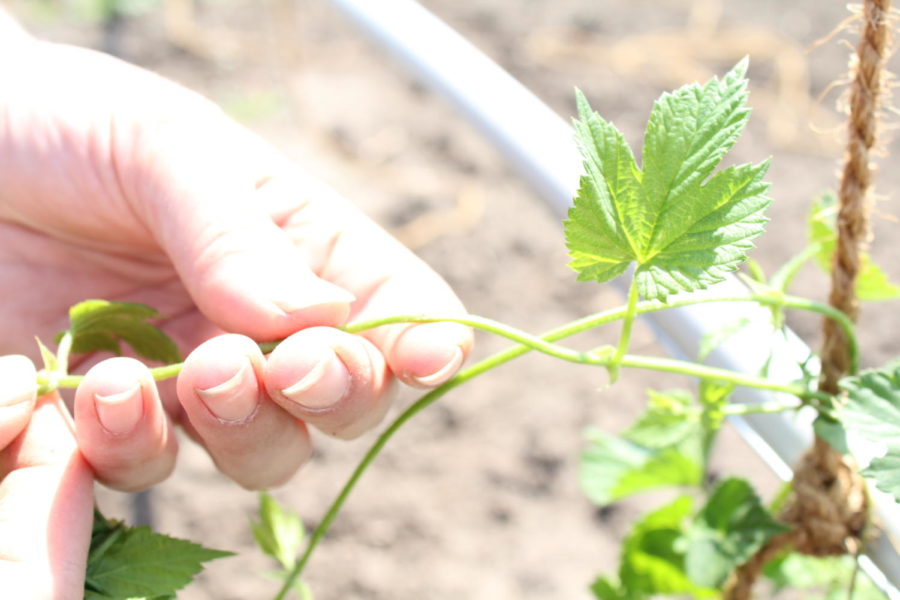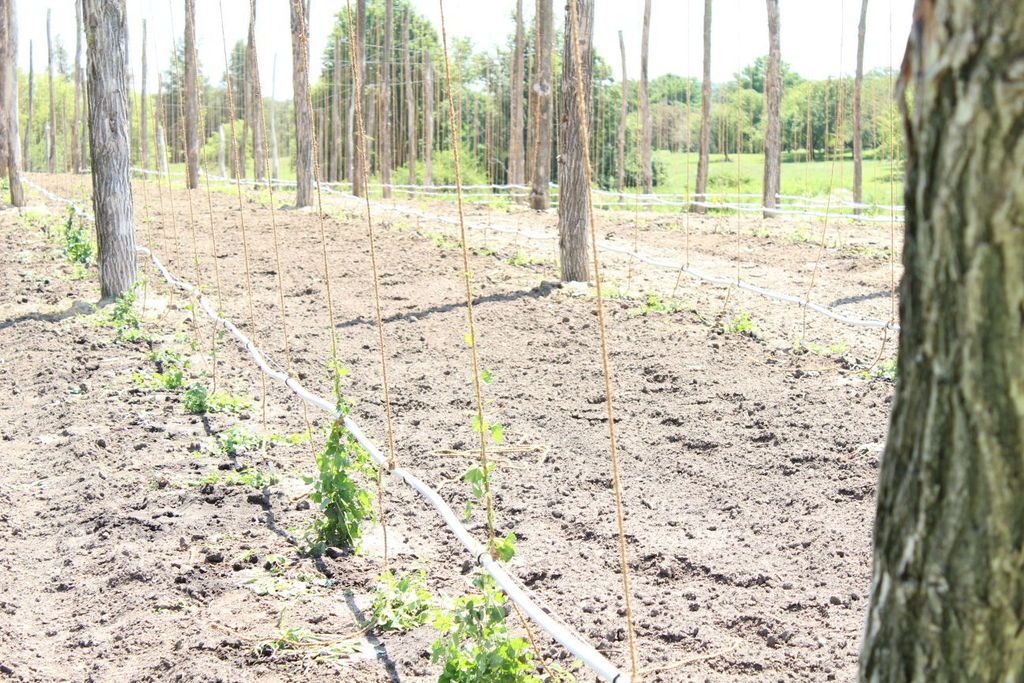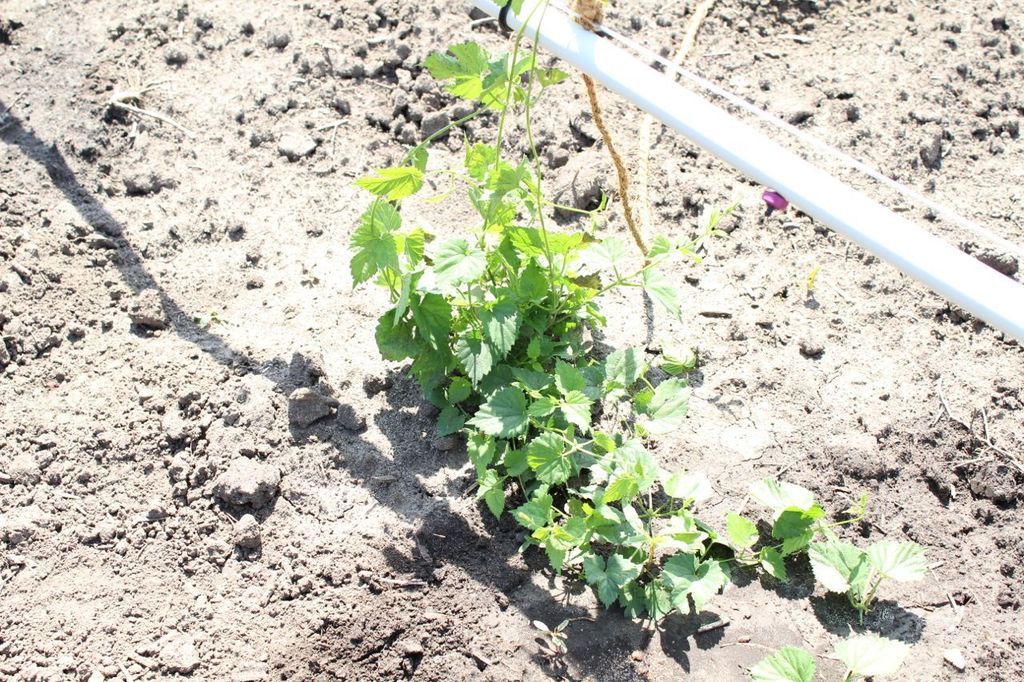Horticulture Research Farm grows plant used in beer
July 28, 2015
Ever wonder where that distinct taste in beer comes from? Most breweries use the hop plant to give beer its bitter flavor.
Diana Cochran, assistant professor of horticulture and extension fruit specialist, has begun research on the hop crop at the Horticulture Research Station.
“When I got here, I guess my department had jokingly mentioned it … my specialty is fruit crops, but hops falls into that, because it’s technically a fruit,” Cochran said.
Cochran and her small team have installed a one-acre hop yard and are now in the process of training the vine-like plants to grow vertically by twisting them around twine.
“You train [bines] to go up the twine … you have to do it a couple times, but then it will start doing it on its own,” Cochran said. “It’s recommended that you do two to three bines per twine.”
A bine is a flexible twining or climbing stem.
The hop yard has been installed with a drip irrigation system, which includes UV tubing to help with water temperature and to protect the tubing from the sun.
“At some point, we will be fertigating. … For this year since it’s a hop establishment year, we just went through and added the nutrients to the soil based on our soil test,” Cochran said.
Cochran eventually wants to set up soil moisture sensors for the irrigation system, so she can program it to water to a certain level, she said.
Typically with the hop crop, it would be close to harvesting time, but Cochran’s new plants came in late and still have a ways to grow.
“My hops came in a lot later than what I would have liked this year,” she said. “Typically you start seeing growth in April, by May you’re training them, then they’re shooting up and then [at the] end of August, you’re harvesting.”
A fully mature plant will produce hop cones, which is the part of the plant used in beer. The vine will also grow 20 feet in one summer.
“It’ll grow … and then it will start flowering and that’s when the flowers turn into the fruiting body, which is the hop cone,” Cochran said.
For now, Cochran is focusing on two cultivars of the hop plant.
“I have six rows of Cascade and then three rows of Chinook, and those are pretty common in most of your IPAs — pale ales,” she said.
The different cultivars are where beer flavoring comes from.
“Basically the different styles are kind of dictated by some of your cultivars, but it’s also more of the process and how long you keep the hops in the beer and the solution that you’re boiling,” Cochran said. “There’s definitely ones that have a higher content of IBU, which you’re looking for. That’s how they term their bitterness. They have different units — aroma hops and bittering hops. Different cultivars might have more bittering units or more aroma units.”
The three most popular cultivars used in beer are what are called “The Three Cs.” They are the Cascade, Chinook and Centennial.
After the plant has fully matured, the fruit, or the hop cones, are removed and can then be sold to breweries in three different forms.
The larger companies tend to purchase the bales and sometimes the hop cones are purchased without being dried to create a wet beer, she said.
Until recently, hops were predominantly grown in the Pacific Northwest. In Iowa, people have been growing the plant for the past five or six years. This was another reason why Cochran decided to start her research.
“Because a lot of the growers in Iowa are still relatively new farmers … and there’s not a lot of information, I wanted to grow with them and I wanted to … mitigate their issues before they have them and help them,” she said.
Cochran said she thinks the popularity of growing hops is because of how fun it is to grow, how fast it grows and it makes beer.
She said she has plans for the future of her hop yard and hopes to install other hop yards throughout Iowa.
“I have 255 plants of mixed cultivars that I want to put in a cultivar trial. What I’d like to do … is set up a few different cultivars and also put them at different locations through Iowa to try to get a better understanding of what cultivars grow here,” she said.
For her current hop yard, Cochran plans to perform fertility and irrigation studies, looking at different nutrient issues, looking into weed management and performing a height study.
“It’s a lot of unknowns, especially out here where we have really rich organic matter in our soils,” she said. “Traditionally, hops like a lot of irrigation and they like a lot of nitrogen. I think in Iowa we have a lot of nitrogen and organic matter already in the soil.”
While beer is the predominant use of the hop plant, studies are revealing that there may be medicinal uses as well, Cochran said.
“There are different scientific studies that say they’ve seen a difference in women with breast cancer. It’s the lupulin glands that are in the hops … that they’re showing could have some medicinal purposes,” she said.
It’s possible for hops to be used as a sleep aid. According to folklore, in medieval times they would place the hop cones under their pillows, she said.
Once Cochran has her hop plants up and running, the hop cones may be sold to help support the research farm, she said.
“It’s kind of a fun project. It gets a lot of excitement from people. For me, I’m one who likes to be behind the scenes,” Cochran said.









